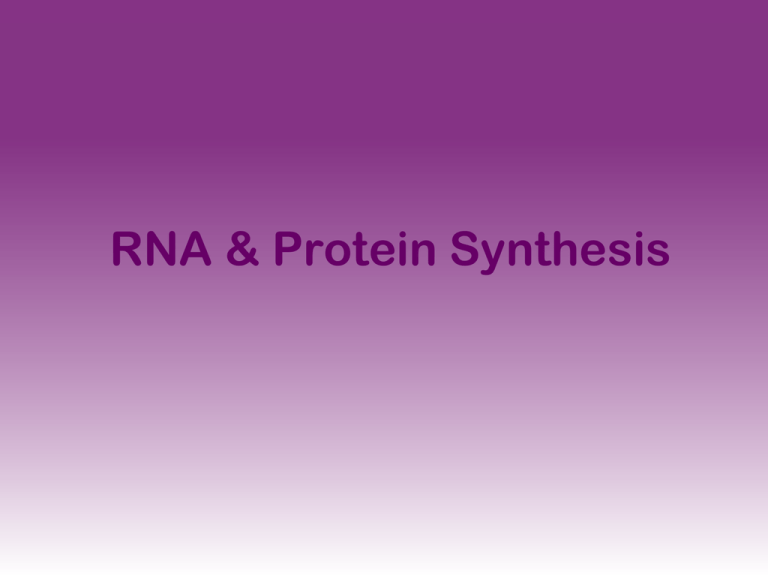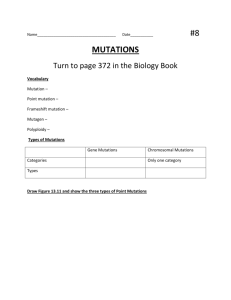cp protein synthesis & mutations powerpoint 2015
advertisement

RNA & Protein Synthesis I. Quick Review A. What are some proteins you are made of? Ex: keratin, hemoglobin, enzymes, antibodies B. What are the building blocks of proteins? Amino acids C. What organelle makes proteins? Ribosomes D. Where are the instructions for making a protein? DNA! E. Where is this molecule located in cell? Nucleus Central Dogma 1. 2. Photo credit: http://katiephd.com/wp-content/uploads/2011/01/central-dogma.jpg The Structure of RNA 1. Phosphate group 2. 5-carbon sugar- ribose 3. Bases i. Adenine ii. Uracil iii. Cytosine iv. Guanine Step 1: Transcription 1. During transcription, RNA polymerase binds to DNA on gene and separates the DNA strands 2. Using one strand of DNA (the gene) as a template, nucleotides are assembled into mRNA (“messenger RNA”) which will leave the nucleus and travel to ribosome Transcription- nucleus B. Translation 1. Translation is the process of decoding the mRNA into a polypeptide chain (protein) 2. Ribosomes read mRNA three bases (1 codon) at a time and construct the proteins copyright cmassengale 3. mRNA transcript start codon AUG attaches to the ribosome 4. Process continues until a stop codon. video End Product –The Protein! 5. The end products of protein synthesis is a primary structure of a protein 6. A sequence of amino acid bonded together by peptide bonds aa2 aa1 aa3 aa4 aa5 aa199 copyright cmassengale 12 aa200 One gene, one polypeptide Translation Second base in codon So how can you tell what amino acid will be carried on the tRNA? Use this chart! Try AUG codonwhat amino acid? (use codon!) First base in codon Third base in codon Name the Amino Acids • • • • • GGG? UCA? CAU? GCA? AAA? copyright cmassengale • All of DNA Translation A. Mutations: Any change in the DNA sequence. Main question: how does that affect the proteins? M u t a t i o n s Ryan Clark of Pittsburgh Steelers Photo source: http://www.dnalc.org/resources/3d/17-sickle-cell.html 1 base change in 438-base sequence. Hemoglobin protein does not work properly to carry oxygen. Can’t Carry Oxygen Tay Sachs http://www.pbs.org/wgbh/nova/body/cracking-the-code-of-life.html Time- 15:00-20:00 Inherited genetic mutation HEXA gene codes for an enzyme that breaks down fatty acids Build up of fatty acids in the brain Mistakes Happen! B. A mutagen is any environmental agent that causes a change in DNA Mutagens can be chemical or physical Ex: UV rays, nuclear radiation, chemicals (benzene, nicotine, pesticides, formaldehyde) Photo credit: http://www.mrwallpaper.com/wallpapers/Plane Photo credit: http://www.realnewsreporter.com/wpcontent/uploads/2011/04/nuclear-429.n.jpg C. Define point mutations: change of 1 base in DNA sequence Diseases Caused by Point Mutations Colorblindness Hemophilia Cystic Fibrosis Important: Tay Sachs If a mutation is inherited, then PKU ALL the cells will have the mutation If a mutation is caused by the environment, ONLY the cells where the DNA is mutated will be affected Types of Point Mutations Original Strand RNA: AUG CCA ACA GAU CAG UAG CGC GUA 1. Substitution AUG CCA ACA GAU CAG UAC CGC GUA 2. Insertion into original ACU GCC AAC AGA UCA GUA GCG CGU A 3. Deletion from original AGC CAA CAG AUC AGU AGC GCG UA The cat ate the rat. Substitution The car ate the rat. Insertion The caa tat eth era t. Deletion Tec ata tet her at. D. Frameshift Mutations • Effects of insertions or deletions are more dramatic • Addition or deletion of a nucleotide causes a shift in grouping of codons • Changes like these are called frameshift mutations Some substitutions don’t cause changes in the amino acids GCC, GCA = alanine CGG, AGG = arginine Remember: there are extra amino acid “words”: 20 A.A.’s, 64 codons! Write this: if amino acid does not CHANGE, the mutation is called “silent” Can you think of when mutations might be GOOD? • Genetic diversity • Sickle cell anemia CAN protect someone against malaria • HIV resistance in humans Mutations Hypertrichosis Chromosomal Mutations








